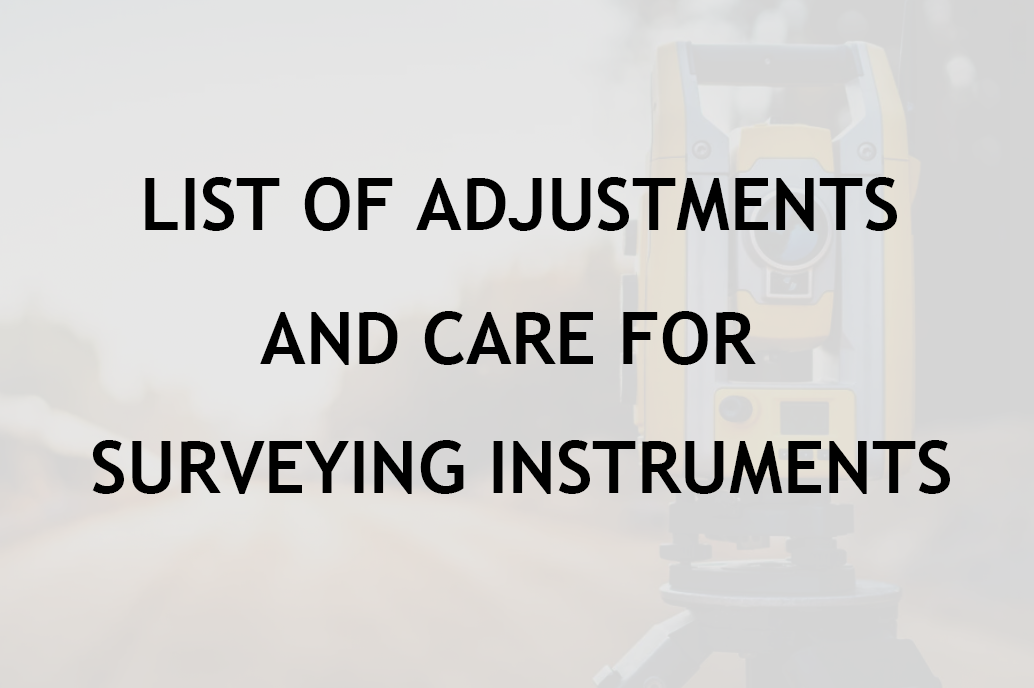ADJUSTMENTS AND CARE OF SURVEYING INSTRUMENTS (StudyCivilEngg.com)
ADJUSTMENTS AND CARE OF SURVEYING INSTRUMENTS
The surveyor must know how to care and adjust the instruments. Surveying instruments are very delicate. These should be handled with care so that they are not damaged or they become out of order. The instruments once damaged need costly repair and cannot be restored to the original condition. If the instruments become out of order, they require adjustments. The surveyor should be able to do most of the routine adjustments. The following general discussions apply to most of the instruments, such as compass, levels and theodolites.
- Study the instruction manual carefully before handling the instrument. Have a thorough acquaintance with the instrument being used.
- Note carefully the positions of the various parts of the instrument in the box before taking it out from the box. This will help in proper replacing the instrument in the box after use.
- While taking out a level or a theodolite from the box, do not lift the instrument by its telescope. Place the palm of the hand under the levelling head or the foot plate and then lift.
- Fix the instrument firmly on the tripod head. If the instrument is not screwed properly, it may fall down.
- While carrying the instrument from one place to the other in field after fixing to the tripod, hold it on the shoulder in a horizontal position with the instrument in the rear, and the legs of the tripod in the front. If overhead obstructions exist or when going through a doorway, carry it under the arm, balanced in the horizontal direction, with the instrument in the front and the tripod in the rear. If the distance is large, place the instrument in the box before carrying it. Alternatively, carry it in lap.
- Never leave the instrument unattended when it is set up on a road, near construction work or in the field where there are animals.
- Protect the instrument from rain, dust and damp. A waterproof bag should be used to cover the instrument when mounted but not being used.
- Push the legs of the tripod firmly into the ground. The legs should be spread well apart for stability. Do not straddle the legs of the tripod. If the tripod has to be set up on a pavement or a smooth surface, its feet should be inserted in joints or cracks. If necessary, provide adequate lateral support by driving pegs into the ground. Alternatively, the three legs should be tied together at the proper distance from the bottom.
- When the instrument is not being used, keep the cap over the objective of the telescope. Never wipe the lenses with linen or ordinary silk. For cleaning the lens, use a camel’s hair brush or a piece of chamois leather or soft silk rag moistened with alcohol. Clean the lens with good quality lens-cleaning liquid or with a mixture of equal parts of alcohol and water. It should not be rubbed, but should be wiped gently and brushed again with camel’s hair brush.
- If the lenses become, wet, let them dry up naturally.
- Keep hands off the graduated circle to prevent its tarnishing. Apply watch oil to the tarnished portion after cleaning it with a camel’s hair brush.
- No part open to dust should be oiled ad left as it is. Such parts should be kept clean and free from oil. Oil tends to collect dust and it becomes sticky at low temperature. The working parts are lubricated with graphite.
- No part of the body or clothing should touch the instrument while taking observations.
- Do not touch the level vials nor breath on them to avoid unnecessary movement of the bubble due to unequal heating of the vial.
- Do not force any screw or any part. The screw or the part should be cleaned and lubricated with watch oil. A gasoline can be used for cleaning.
- Do not over tighten the various clamp screws, adjusting screws, levelling screws, etc. Just bring them to a firm bearing.
- When the observation is not being taken, lift the needle of the magnetic compass off the pivot to prevent its becoming sluggish.
- The steel tape should be wiped dry after use to prevent its rusting. Take special care when working near electric power lines, as the fatal accident may occur if the metallic or steel tape touches the power line. Do not allow an automobile to run over a tape.
- Rub a thin film of watch oil over the exposed parts of the instrument when used near the sea coast to prevent the appearance of oxide due to salt water. To remove such oxide spots if formed, first use a camel’s hair brush and then apply watch oil. After a few hours, rub it dry with a soft piece of linen.
- Mud, clay or sand sticking to the feet of the tripod legs must be removed. The tripod should be wiped with a damp cloth and dried. The metal parts should be coated with a light film of oil and wiped with a clean cloth.
FAQs COVERED IN THIS POST
WHAT ARE THE ADJUSTMENTS TO BE MADE FOR SURVEYING INSTRUMENTS?
HOW CAN A SURVEYOR ADJUST THE SURVEYING INSTRUMENTS?
HOW TO CARE THE SURVEYING INSTRUMENTS?
WHAT ARE THE ROUTINE ADJUSTMENTS OF SURVEYING INSTRUMENTS?
HOW TO KEEP THE SURVEYING INSTRUMENTS WITHOUT GETTING DAMAGED?
LIST OUT THE ADJUSTMENTS TO BE MADE FOR SURVEYING INSTRUMENTS
LIST OUT THE DAILY ROUTINE TO KEEP THE SURVEYING INSTRUMENTS SAFE





Post a Comment